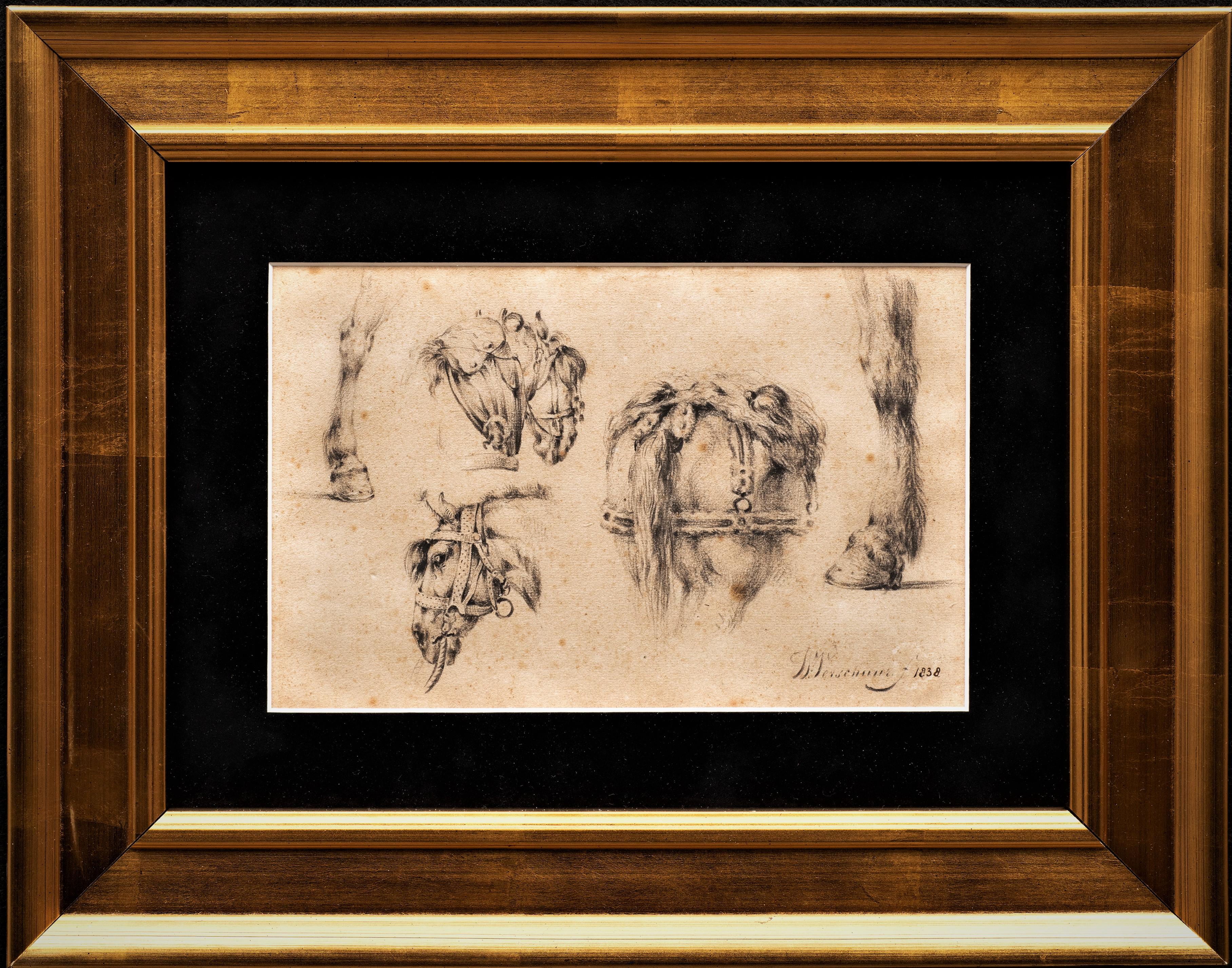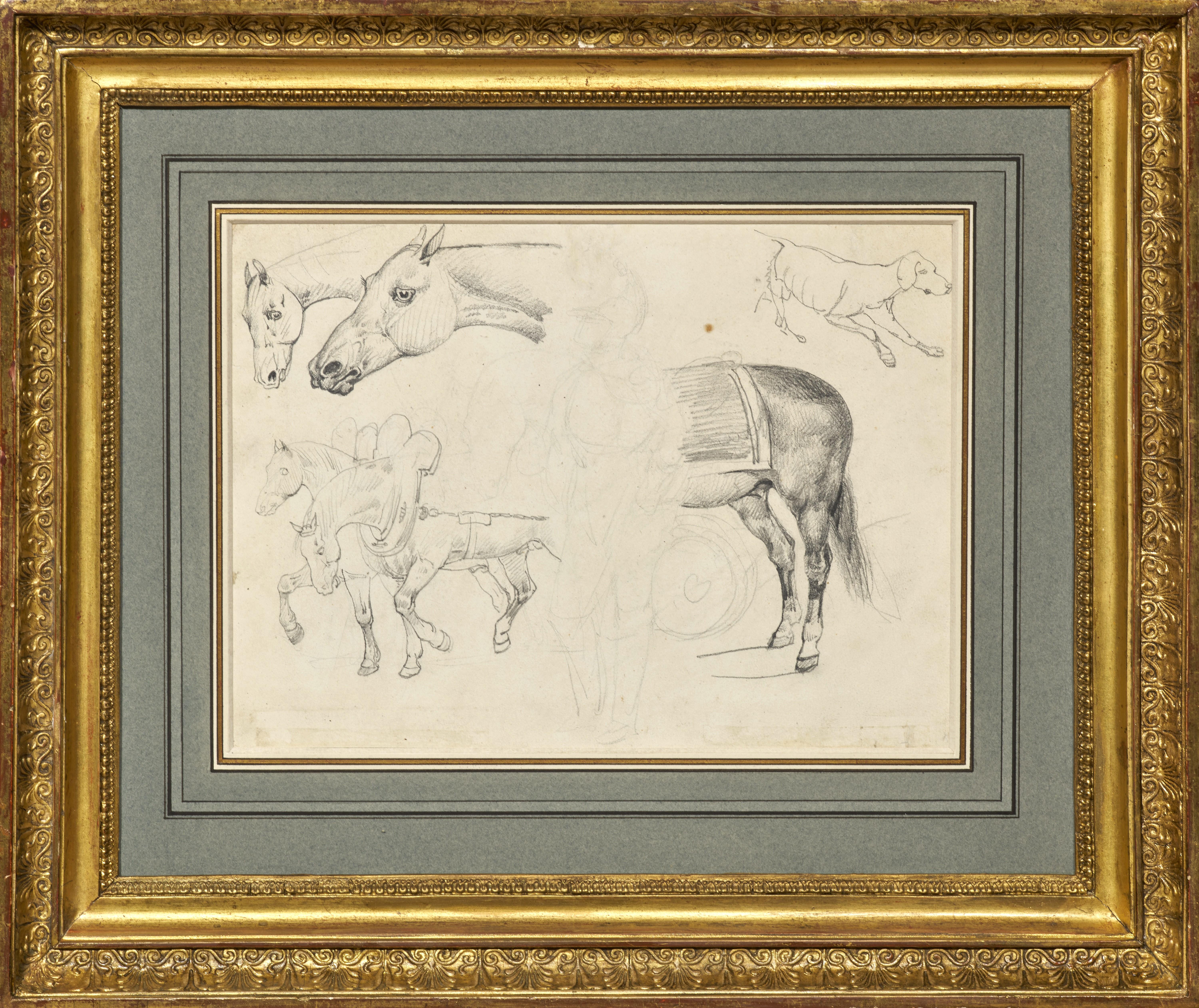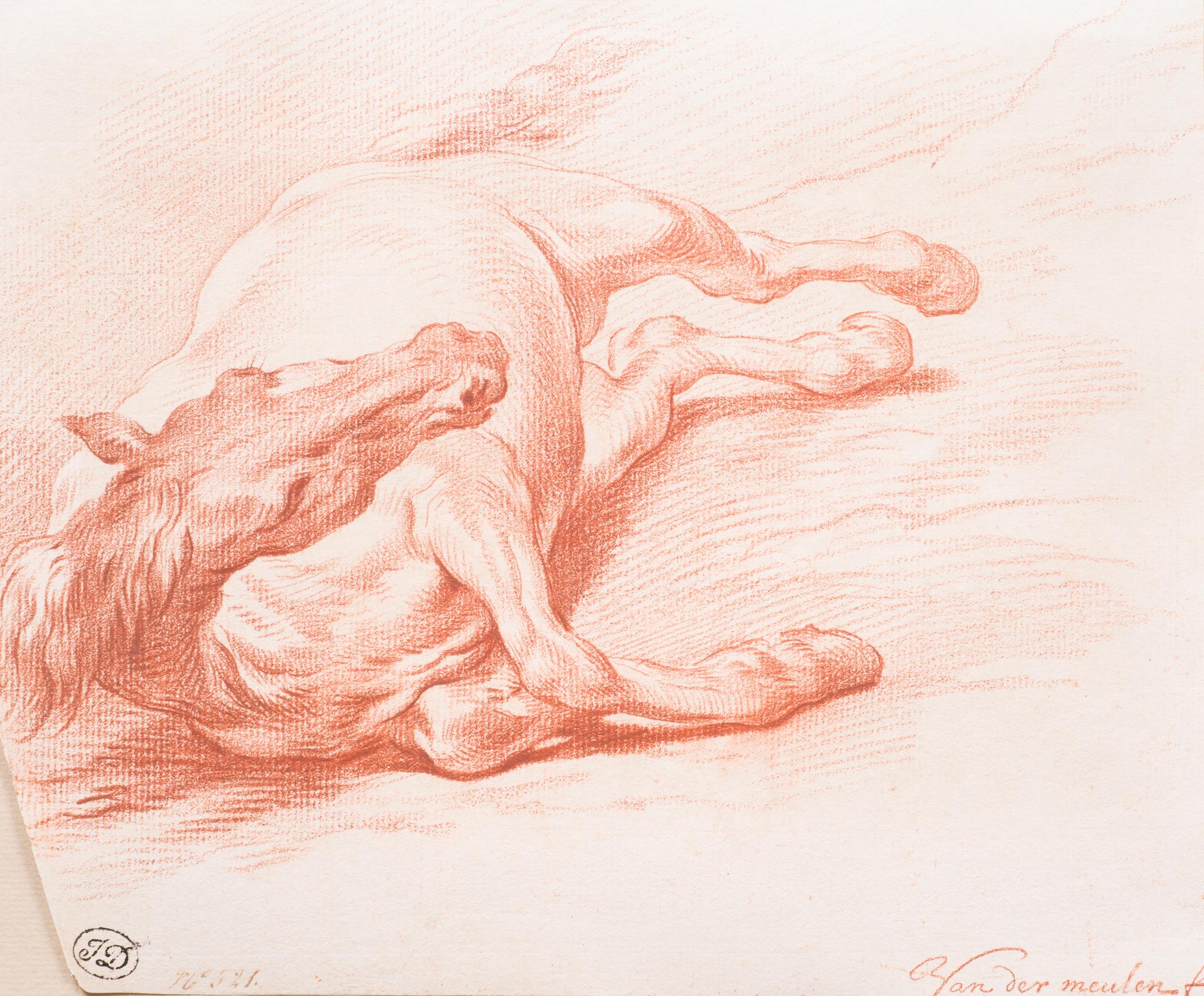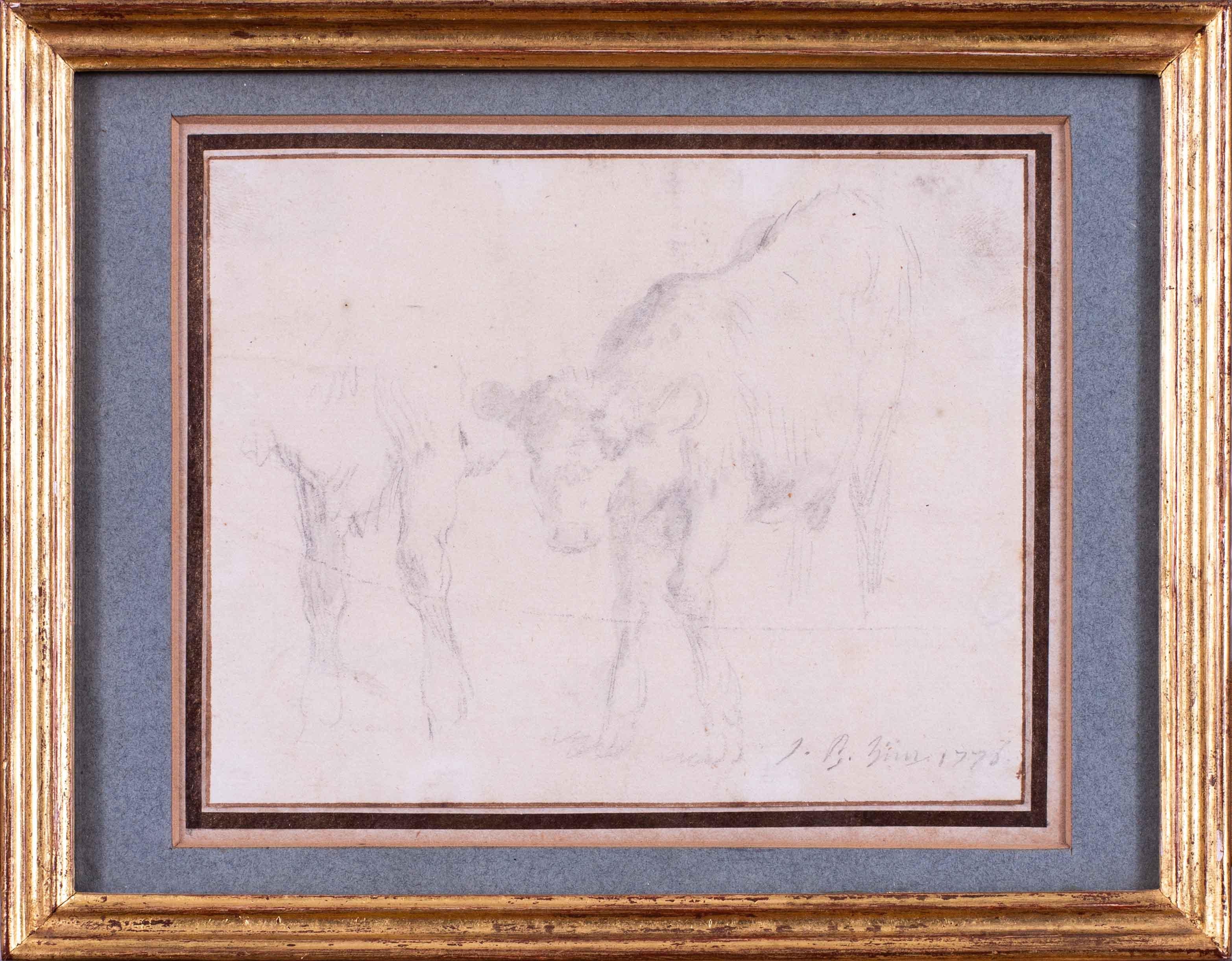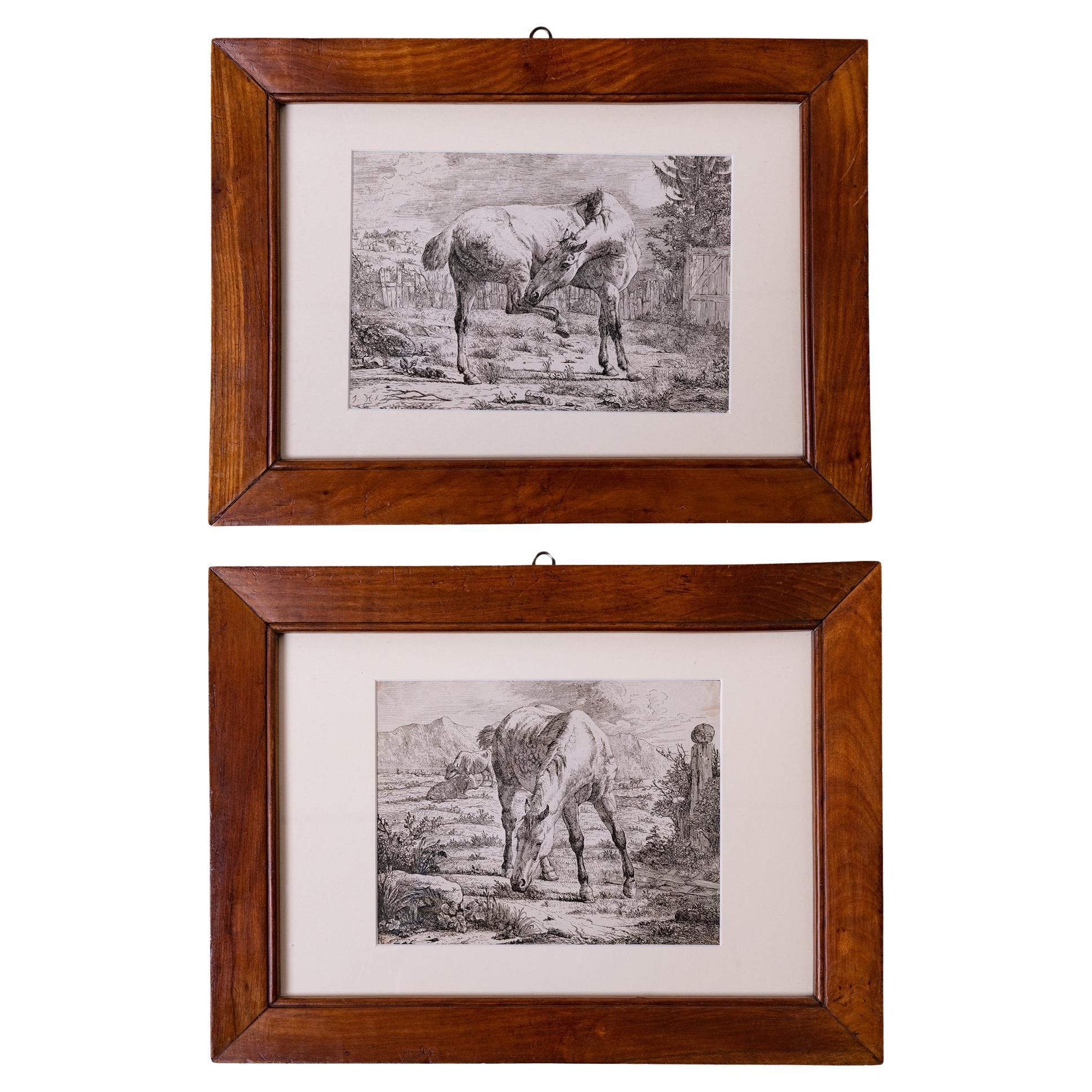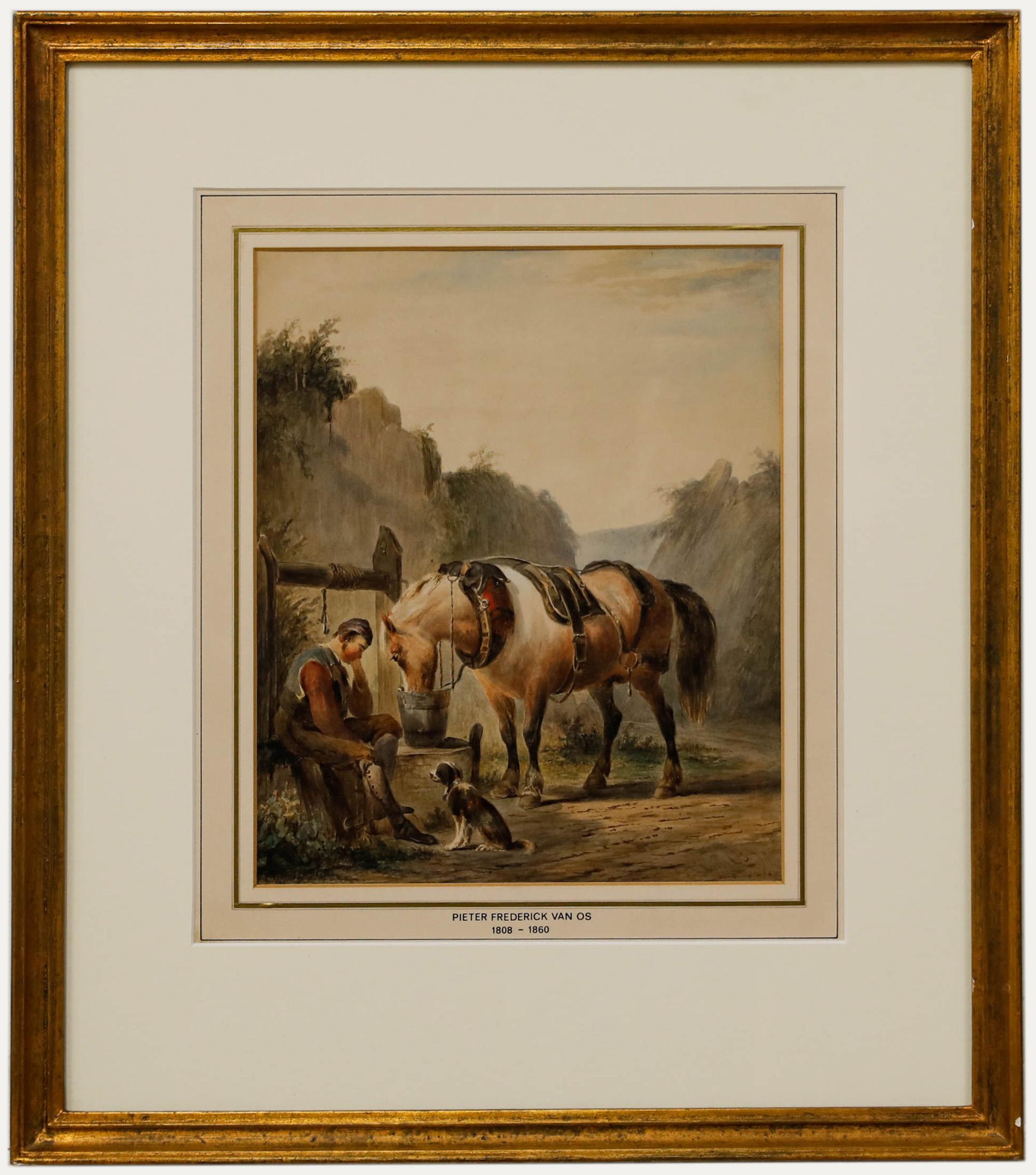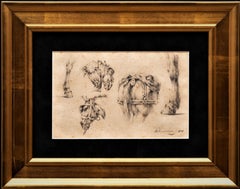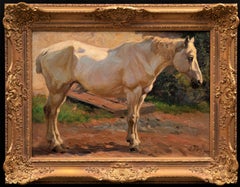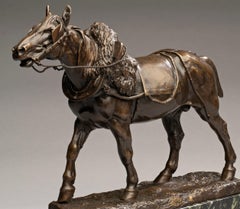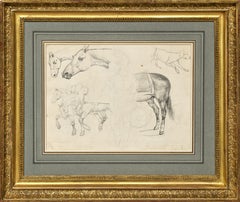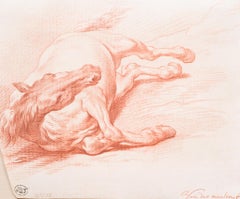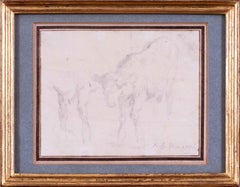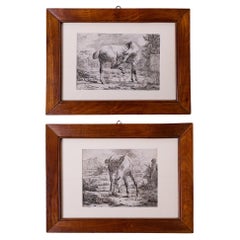Items Similar to Antique Horse Study; Legs and Rumps, 1838" Wouterus Verschuur (Dutch, 1812-1874)
Want more images or videos?
Request additional images or videos from the seller
1 of 10
Wouterus Verschuur lAntique Horse Study; Legs and Rumps, 1838" Wouterus Verschuur (Dutch, 1812-1874)
$5,850
£4,443.22
€5,110.51
CA$8,173.60
A$9,114.49
CHF 4,755.55
MX$111,838.17
NOK 60,530.57
SEK 57,351.40
DKK 38,141.66
Shipping
Retrieving quote...The 1stDibs Promise:
Authenticity Guarantee,
Money-Back Guarantee,
24-Hour Cancellation
About the Item
Antique Horse Study
"Legs and Rumps, 1838"
Wouterus Verschuur l (Dutch, 1812-1874)
Pencil on paper
Signed and Dated "W Verschuur 1838"
10 x 6 1/2 (17 1/2 x 14 frame) inches
In his time Wouterus Verschuur was an acclaimed and celebrated painter of horses. Through careful observation he learned to capture their physique and movement to perfection. As a true-born romanticist he was also interested in their character, thereby painting powerful carthorses in their stable, thoroughbred saddled horses during an afternoon ride or harnessed horses in action.
He was born to an Amsterdam jeweler and received his training from the landscape and cattle painters Pieter Gerardus van Os and Cornelis Steffelaar. As part of this education Verschuur had to copy works by the 17th century painter Philips Wouwerman. Like Wouwerman, Verschuur's subjects consist mostly of stable scenes, landscapes with horses and coastal landscape. These works reflect the enduring influence of the northern Baroque masters on nineteenth century art, revealing the artist's close study of his Dutch and Flemish predecessors harking back to Peter Paul Rubens.
Showing talent from a very early age, at 15 Verschuur had a painting exhibited at the "Exhibition of Living Masters" at Amsterdam in 1828. In 1832 and 1833 he won the gold medal at the annual exhibition at Felix Meritis. In 1833 he was appointed a member of the Royal Academy in Amsterdam. In 1839 he joined the artists' society, Arti et Amicitiae.
His reputation was also considerable abroad. He was often featured in the annual exhibitions which travelled the large European cities at that time. In 1855 Napoleon III purchased one of his paintings at the Exposition Universelle in Paris.
The Verschuur horse revels in its physicality, like a quintessential Baroque horse, built with the distinct meaty roundness popularized by Rubens and passed down through his student Van Dyck. These details of realism reveal years of close observation of equine physiology. He was well-respected and admired by his peers for his technical skill his ability to capture the power and beauty of working horses, understanding of the fluidity of a horse's movement.
Like his contemporary Rosa Bonheur, Verschuur found great commercial success during his lifetime, travelling frequently to Paris and exhibiting at the 1855 Exposition Universelle in the newly built Palais de L’Industrie, where his works were purchased by Emperor Napoleon III. This royal patronage acknowledged Verschuur’s status as a continuation of the proud international tradition of horse painting set forth by Rubens, Van Dyck, and George Stubbs, celebrated for the careful representation of great sporting and war horses, while extending this treatment to the glory of the everyday working horse.
During one of his frequent trips Wouterus Verschuur died on July 4 in the town of Vorden in the Eastern Netherlands. He left behind an oeuvre of about four hundred paintings and over two thousand drawings. Amongst his students were his son Wouterus Verschuur Jr. and Anton Mauve.
The work of Verschuur is represented in several museums including the Stedelijk Museum, Amsterdam, the Rijksmuseum Twenthe, Enschede and Amsterdam Museum.
- Creator:Wouterus Verschuur l (1812 - 1874)
- Dimensions:Height: 17.5 in (44.45 cm)Width: 11 in (27.94 cm)
- Medium:
- Movement & Style:
- Period:
- Condition:The paper is in good condition; some slight foxing, small losses, etc. The frames are new.
- Gallery Location:SANTA FE, NM
- Reference Number:1stDibs: LU1408211978372
About the Seller
5.0
Platinum Seller
Premium sellers with a 4.7+ rating and 24-hour response times
Established in 1995
1stDibs seller since 2020
117 sales on 1stDibs
Typical response time: <1 hour
- ShippingRetrieving quote...Shipping from: Santa Fe, NM
- Return Policy
Authenticity Guarantee
In the unlikely event there’s an issue with an item’s authenticity, contact us within 1 year for a full refund. DetailsMoney-Back Guarantee
If your item is not as described, is damaged in transit, or does not arrive, contact us within 7 days for a full refund. Details24-Hour Cancellation
You have a 24-hour grace period in which to reconsider your purchase, with no questions asked.Vetted Professional Sellers
Our world-class sellers must adhere to strict standards for service and quality, maintaining the integrity of our listings.Price-Match Guarantee
If you find that a seller listed the same item for a lower price elsewhere, we’ll match it.Trusted Global Delivery
Our best-in-class carrier network provides specialized shipping options worldwide, including custom delivery.More From This Seller
View AllAntique Horse "Heads, Hooves, Rump 1838" Wouterus Verschuur (Dutch, 1812-1874)
Located in SANTA FE, NM
Antique Horse Study
"Heads, Hooves and Rump, 1838"
Wouterus Verschuur (Dutch, 1812-1874)
Pencil on paper
Signed and Dated "W Verschuuur 1838"
10 x 6 1/2 (17 1/2 x 14 frame) inches
In his time Wouterus Verschuur was an acclaimed and celebrated painter of horses. Through careful observation he learned to capture their physique and movement to perfection. As a true-born romanticist he was also interested in their character, thereby painting powerful carthorses in their stable, thoroughbred saddled horses during an afternoon ride or harnessed horses in action.
He was born to an Amsterdam jeweler and received his training from the landscape and cattle painters Pieter Gerardus van Os and Cornelis Steffelaar. As part of this education Verschuur had to copy works by the 17th century painter Philips Wouwerman. Like Wouwerman, Verschuur's subjects consist mostly of stable scenes, landscapes with horses and coastal landscape. These works reflect the enduring influence of the northern Baroque masters on nineteenth century art, revealing the artist's close study of his Dutch and Flemish predecessors harking back to Peter Paul Rubens.
Showing talent from a very early age, at 15 Verschuur had a painting exhibited at the "Exhibition of Living Masters" at Amsterdam in 1828. In 1832 and 1833 he won the gold medal at the annual exhibition at Felix Meritis. In 1833 he was appointed a member of the Royal Academy in Amsterdam. In 1839 he joined the artists' society, Arti et Amicitiae.
His reputation was also considerable abroad. He was often featured in the annual exhibitions which travelled the large European cities at that time. In 1855 Napoleon III purchased one of his paintings at the Exposition Universelle* in Paris.
The Verschuur horse revels in its physicality, like a quintessential Baroque horse...
Category
1830s Romantic Animal Drawings and Watercolors
Materials
Pencil, Paper
Antique Horse Painting "Standing Grey Horse, Facing Right" Georg Wolf dated 1907
Located in SANTA FE, NM
Antique Horse Painting
“Standing Grey Horse, Facing Right”
Georg Wolf (Germany 1882-1962)
Oil on canvas
Signed and dated 1907 lower right
27 x 19 (35 x 27 frame) inches
With it's bobbed tail cut short so it doesn't become tangled, it's apparent that this fine specimen was a draught horse...
Category
Early 20th Century Post-Impressionist Animal Paintings
Materials
Canvas, Oil
Antique Dog Painting Collies in Horse Stable w/ Saddle and Blanket, 19th century
Located in SANTA FE, NM
Antique Dog Painting "Collies in Horse Stable with Saddle and Blanket"
Auguste Vimar (French 1851-1916)
Circa 1900
21 x 17 1/2 (29 x 25 1/2 frame) inches
An excellent depiction of collies in the barn awaiting their master. The color and textures are very evocative of an actual stable right down to the hay scattered about. With its original frame, this is quite the statement piece.
Auguste Vimar was a French painter, sculptor, designer and illustrator though he is best known for his talents as an illustrator. He illustrated great classics like La Fontaine's Fables or books by his friends, such as L'Arche de Noé by Paul Guigou...
Category
Early 1900s Realist Animal Paintings
Materials
Canvas, Oil
Antique Bronze Portrait Draft Horse by Isidore Jules Bonheur (France, 1827-1901)
By Isidore Jules Bonheur
Located in SANTA FE, NM
Antique Bronze Portrait of a Draft Horse
Isidore Jules Bonheur (France, 1827-1901)
Circa 1840s
Cast bronze mounted on a rectangular plinth atop a marble s...
Category
1870s Realist Figurative Sculptures
Materials
Bronze
"Very Large Draft Horse Standing in a Barn" Georg Wolf (German, 1882-1962)
Located in SANTA FE, NM
“A Very Large Draft Standing Horse in the Stable”
Georg Wolf (Alsace/Germany 1882-1962)
Oil on canvas
39 1/2 x 21 1/2 (50 1/4 x 42 1/4 frame) inches
Estate stamp and inventory No. 17...
Category
Early 20th Century Post-Impressionist Animal Paintings
Materials
Canvas, Oil
Antique Horse Bronze Trotting Stallion Isidore Jules Bonheur (France, 1827-1901)
By Isidore Jules Bonheur
Located in SANTA FE, NM
Antique Horse Bronze
Portrait of a Trotting Stallion
Isidore Jules Bonheur (France, 1827-1901)
Cast bronze mounted on a rectangular plinth with dark brown patina,
Signed: I. BONHEUR
17 x 11 3/4
A brilliant exploration of a stallion in full trot. The patina is a deep, warm walnut brown with honey-colored tones.
Isidore Bonheur was best known and the most distinguished of the 19th century French animalier sculptors. Isidore, the younger brother of Rosa Bonheur and older brother of Auguste, began his studies of painting initially with his father, who was friends with Francisco Goya. By 1848 he debuted at the Paris Salon having discontinued animal and landscape painting to concentrate on creating sculptures and in 1849, Bonheur enrolled at the Ecole des Beaux Arts. He won medals at the Paris Salon in 1859 and did so again in 1865 and in 1869. After entering the Exposition Universelle 1855, he won the Gold Medal in 1889. In the 1870s exhibited in the London at the Royal Academy of Arts where he earned great prestige and won the coveted Medaille d’Or. After winning numerous other medals and prizes, Bonheur was awarded the Legion d' Honneur in 1895 and he was Knighted in Portugal, Spain and France. Bonheur continued exhibiting at the Paris Salon until 1899.
Many of his bronzes were fabricated at the foundry owned by Hippolyte Peyrol, Bonheur's brother-in-law by marriage to Isidore’s youngest sister Juliette Bonheur. The Peyrol casts for both Rosa and Isidore are exceptionally well executed which suggests a strong working relationship between the founder and sculptor. There is little doubt that Isidore Bonheur was an acute observer of nature; his animals were not anthropomorphized but modelled to catch movement or posture characteristics of the particular species he was sculpting. He achieved this most successfully with his sculptures of horses which are usually depicted as relaxed rather than spirited. These figures are among his most renowned works and his equestrian models became very popular, particularly among the British aristocracy.
An acute observer of nature, his sculptures reflect his commitment to the Realist school - with precise detailing of the movements of animals in their natural habitats. Ultimately, His naturalistic studies of animals are now some of the most highly sought after works by any of the animalier. He was possibly inspired by his many visits to the Buffalo Bill Wild West Show...
Category
1870s Realist Figurative Sculptures
Materials
Bronze
You May Also Like
Double-sided Horse Studies by Théodore Géricault
By Jean Louis Andre Theodore Gericault
Located in PARIS, FR
Recto: two horses, preparatory study for the lithograph "Les Boueux" ("The Muddy Ones")
Verso: four studies of horse heads (including two preparatory studies for the watercolor "Plowing in England"), a study of a life guard with the rump of his horse (preparatory to the lithograph "A Party of Life...
Category
1820s Old Masters Animal Drawings and Watercolors
Materials
Carbon Pencil
Study of a horse lying on its right side seen from the front
By Adam Frans van der Meulen
Located in Stockholm, SE
Provenance:
Jean-Marc Du Pan (1785–1838), Geneva (L. 1440), passed to his brother
Alexandre-Louis Du Pan (1787–1846);
his sale, Geneva, March 26–28, 1840, included in lots 913–917;
...
Category
17th Century Old Masters Animal Drawings and Watercolors
Materials
Paper, Crayon
18th Century Old Master pencil study of cows by French artist Jean Baptiste Huet
Located in Petworth, West Sussex
A rare and charming study of cows by 18th Century French painter, engraver and designer Jean-Baptiste Huet.
The details are:
Jean Baptiste Huet (French, 1745 – 1811)
Study of cows
P...
Category
18th Century Old Masters Animal Drawings and Watercolors
Materials
Pencil
Antique Etchings of Horses
By Jan Frans Van den Hecke
Located in Alessandria, Piemonte
Pair of antique etchings from the 17th Century by Johannes Van Den Hecke (1620-1670): he was a Flemish Baroque painter, draughtsman, printmaker and engraver, mainly known for his sti...
Category
Antique Mid-17th Century Dutch Other Prints
Materials
Paper
$2,143 / set
Pieter Frederick van Os (1808-1892) - 20th Century Oil, A Horse Watering
By Pieter Frederik van Os
Located in Corsham, GB
This atmospheric painting depicts a tranquil rural scene, with a figure tending to a draught horse on a dusty path amid towering cliffs. The composition balances the intimate foregro...
Category
20th Century Animal Paintings
Materials
Oil
Horse - Drawing by Joseph Alexander Colin - Mid-20th Century
Located in Roma, IT
Horse is a drawing realized by Joseph Colin in the Mid-20th Century.
Pencil on ivory-colored paper
Good conditions with slight foxing.
The artwork is realized through deft express...
Category
Mid-20th Century Modern Figurative Drawings and Watercolors
Materials
Pencil, Paper
More Ways To Browse
Animal Legs
War Horse
Horse Leg
George Holland
Nineteenth Century Drawings
Dutch Realism
Pencil Leg
Pencil Drawings Of Horses
Painting Dutch Town
Horse Painting Stable
Dutch Romantic Paintings
17th Century Horse
Drawing Of Napoleon
Horse Pencil Drawings
Cattle Watercolor
Thoroughbred Horse
Harness Horse
Thoroughbred Paintings
